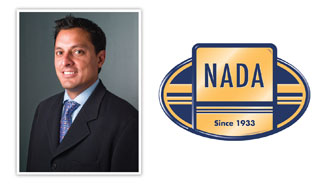NADA UCG: Strong Used Trade-In Values to Push New Sales in 4Q; Didn’t Hurt Used Sales Last Month

Thanks to used-car trade-in values being above average, the new-car market is likely to see a nice lift during the fourth quarter, according to NADA Used Car Guide senior analyst Jonathan Banks.
Interestingly enough, though, high trade-in values didn’t keep used sales from remaining strong in September, Banks pointed out in a video interview with NADA public affairs vice president David Hyatt.
“What was surprising is the strength we saw in the used market, because what we expected is that consumers may be moving from used vehicles to new because of the strength in trade-in values, but what we saw actually was an improvement in both markets,” he explained.
“One thing (to account for that) is really pent-up demand,” Banks added. “And a lot of that is driven by the fact that the age of the vehicle fleet out there is really quite old. It’s about 10.7 years old, which is an old vehicle where consumers are starting to be concerned about repair costs.
“So they need to back in the market and get either a new vehicle or a newer vehicle in the used market,” he noted, also sharing that incentives helped the new-car market, as well, as they were quite strong for trucks and SUVs.
As for the fourth quarter, new-vehicle sales are likely to be fairly healthy, as well, due to the high trade-in values and incentives.
“We expect consumer demand for small and midsize fuel-efficient cars to shift from the used market to the new market in the fourth quarter,” Banks said. “Automakers based in Japan will likely increase incentives to boost lost market share after the production disruptions from the earthquake and tsunami in March.”
Several three- to five-year-old small cars — like the Chevrolet Cobalt, Honda Civic and Toyota Corolla — saw their trade-in values go up around 10 percent year-over-year last month, NADA Used Car Guide indicated.
“Higher trade-in values will help facilitate new vehicle purchases because car owners have an equity built into the deal, which they can use as a down payment,” Banks continued. “Higher used prices will also drive more car shoppers to choose new vehicles instead of used ones because monthly payments between a new and used purchase will be closer.”
Moving along, Banks also took a look at where used prices might be at the end of 2011. He expects them to still beat out year-ago levels. However, they are likely to be much more moderate than the peak levels in May and June.
Used supply for the fourth quarter is expected to be restricted, Banks said, citing the leasing dry-up that started in 2008.
“That supply, coming back, of three-year-olds is essentially gone, which means that dealers are going to have a challenge trying to find nearly new used vehicles on their lots,” he noted. This “bodes well for pricing because there will be a lot of competition for a limited supply of vehicles.”
Of course, in the past couple of months, there has been some alleviation in used prices — particularly for small and midsize cars — after the market hit record levels this spring, Banks stressed.
“So that fall-off was expected. We expected prices to subside because they’re coming off such a high peak,” he added. Gas prices calmed down and shopper have behaved “a bit more rational” when it comes to used small and midsize used cars.
Used-car prices are still showing around a 10-percent year-over-year lift and are likely to still exceed year-ago levels at the end of 2011, Banks emphasized in the interview. However, they won’t likely show the same dramatic 25 percent to 30 percent spikes spotted this spring in the small-car segment.

 View The Latest Edition
View The Latest Edition

